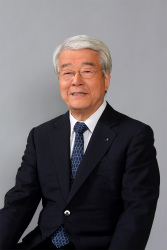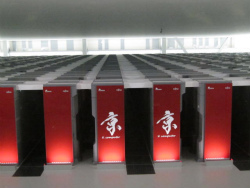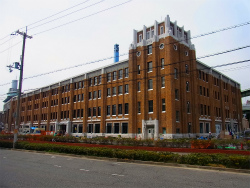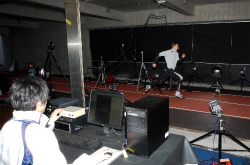実施日 : 2013年01月30日(水) - 31日(木)
Notice: Press Tour “Driving Force of Kobe’s Revival” Urban Strategies to attract Creative Person:“Biomedical Innovation Cluster” and “City of Design”(January 30-31, 2013)
投稿日 : 2013年08月22日
Professor Shinya Yamanaka, Director, M.D., Ph.D., of the Center for iPSCell Research and Application of Kyoto University, won the Nobel Prize for Physiology or Medicine last year. This has boosted the expectations of society regarding regenerative medicine and the treatment of intractable illnesses by making use of iPS cells. Meanwhile, the RIKEN Center for Developmental Biology, located in the Kobe Biomedical Innovation Cluster, has been preparing to start a clinical study of retinal cells using iPS cells as early as April this year. If realized, the study will be the world’s first clinical research. RIKEN also operates the K computer, which became the world’s fastest computer in 2011 and attracts medical industries, research organizations and researchers from all over the world to Kobe.
The Kobe Biomedical Innovation Cluster, on which the city has been working in the man-made island of Port Island, started in 1998 as the center project for Kobe’s economic rehabilitation after the Hanshin-Awaji Great Earthquake in 1995. At present, 221 medical companies and organizations have advanced to Port Island where medical industries are integrated. It is estimated that in FY2010 the economic ripple effect reached 104.1 billion yen; the Kobe Biomedical Innovation Cluster demonstrates its presence as the driving power of Kobe’s revitalization.
The new city strategy of Kobe, which has been steadily progressing toward revitalization, is the “City of Design, Kobe.” This is a project to create new attractions of Kobe, by vitalizing tourism and creating an attractive landscape making use of local resources and by developing industries, by means of the power of design that draws people’s attention and moves their hearts. Kobe was designated a Design city of the Creative Cities Network under the patronage of UNESCO in 2008. In August 2012, the Design and Creative Center Kobe was established as the base for training people who can contribute to society through design, for sending out information, and for exchanging. This center is intended to let the world know about the “City of Design, Kobe.”
The tour will visit the Kobe Biomedical Innovation Cluster, the driving power of Kobe’s reconstruction after the Hanshin Awaji Great Earthquake, to cover RIKEN’s K computer and the clinical research into iPS cells, and look into the city strategy of a “new born” Kobe which comes up with new magnetism and vitality in terms of design.
【 Presentations 】 1. Press Conference by Kobe Mayor Tatsuo Yada
1. Press Conference by Kobe Mayor Tatsuo Yada
Kobe City in concert with citizens and enterprises has achieved complete restoration from the Great Hanshin-Awaji Earthquake of 18 years ago. Mayor Yada’s achievements include the running of world top-class K computer, which is the core facility of the Kobe Biomedical Innovation Cluster, and also the opening of Design Creative Center Kobe, the symbol of Design City Kobe. These will contribute to the growth of Kobe City in the next generation. These achievements are based on the policy of “a city created by citizens, a city in contact with the world”, which Mr. Yada has been initiating since he became Mayor in 2001.
The press tour will interview Mayor Yada on Kobe City’s growth strategies such as “Kobe Biomedical Innovation Cluster” and “City of Design, Kobe”. The tour will also board a boat to see the beautiful townscape of Kobe from the bay.
 2. Kobe Biomedical Innovation Cluster
2. Kobe Biomedical Innovation Cluster
Kobe City has been runnning “Kobe Biomedical Innovation Cluster” since 1998. Its aims are creating employment and revitalizing the local economy; providing advanced medical services and welfare for Kobe citizens, and contributing to improvement of medical technologies in Asian countries.
Kobe Biomedical Innovation Cluster includes the Institute of Biomedical Research and Innovation Hospital (IBRI), which supports clinical trial and translational research in three fields: regenerative medicine, medical imaging technology, and pharmaceutical research. The cluster is also home to a world-class research institute in generative medicine related to iPS cells: Center for Developmental Biology (CDB), RIKEN.
In this tour, Mr. Takashi Miki, Director of Kobe Biomedical Innovation Cluster Promotion Headquarters, will brief on an outline of Kobe Biomedical Cluster and, followed by a visit to the Center for Developmental Biology (CDB) and K computer, RIKEN.
2-1. The Center for Developmental Biology (CDB) , RIKEN
The Center for Developmental Biology (CDB) was launched at RIKEN in 2000 funded by the Japanese government. It conducts researches from fundamental studies of animal development to the theme of making a contribution to regenerative medicine. Its scale of budget was 3.9 billion yen in FY2012. It employs 547 researchers and staff (as of December 2011). CDB carries out three main pillars of research: mechanisms of development, organogenesis, and the study of regeneration. It has a wide range of projects from basic research to practical application.
This tour covers regenerative medicine. We will have briefings on CDB’s research projects such as usage of ES cells and iPS cells.
2-2. K Computer, RIKEN
In the ranking of supercomputers in 2011, “K computer” took the first place in the world and third place in the ranking of November 2012 on the measurement of its performance. At the latest ranking in November 2012, K computer showed its overall ability by receiving top ranks in three of the four benchmarks at the 2012 HPC Challenge Awards in Salt Lake City at SC12, the International Conference.
K computer has the ability to perform over 10 Peta (10 to the 16th power) floating-point number of operations per second, which can calculate vast amounts of data at high speed and enable a variety of simulations. It is expected to accelerate research and benefit Kobe Biomedical Innovation Cluster in the field of life science. It will be possible to issue confident natural disaster warnings and more accurate forecasts of earthquake and tsunami. Since September 2012, more than 140 research projects, both academic and industrial, have been started up.
In this tour, Mr. Mitsuo Yokokawa, Director of Operations and Computer Technologies Division, RIKEN, will give us a briefing on the development process of K computer and introduce some research projects utilizing the K computer.
 3. City of Design, Kobe
3. City of Design, Kobe
Since the opening of the port of Kobe in 1868, Kobe City has been adopting foreign cultures and fostering an open-minded atmosphere. That atmosphere can be seen within the design of Kobe: community designs, daily life designs, and manufacturing designs.
In this tour, Mr. Osamu Kinugasa, Manager of the Design City Promotion Office, Kobe City, will brief on an outline of “City of Design, Kobe” at the Design Creative Center Kobe, followed by interviews with artists and designers based on this center. The tour will also visit the site of “Community Design” and “Manufacturing Design”.
For “Community Design,” the tour covers “Kobe Tetsujin Project,” in Nagata Ward which suffered tremendous damage from the Great Hanshin-Awaji Earthquake. It is a revitalizing project initiated by the community using a well-known Manga character.
For “Manufacturing Design,” the tour visits the ASICS, a manufacturer of sports goods that originated in Kobe. It develops business shoes that can be used for a function that has grabbed public attention since the Great East Japan Earthquake.
 3-1. “Community Design”: Kobe Tetsujin Project (Nagata Ward)
3-1. “Community Design”: Kobe Tetsujin Project (Nagata Ward)
When the Great Hanshin-Awaji Earthquake hit Kobe on January 17, 1995, the area to the south of Shin-Nagata Station was heavily affected by the disaster; 83% of the buildings either collapsed or burnt down. Since the urban infrastructure around the station has been restored, this area has livened up again as the town of “Tetsujin” and “The Three Kingdoms”.
After the quake, restoration of the infrastructure was completed very quickly but the former liveliness of the town was not coming back so easily. To solve this problem, local shop-owners pitched in and planned to build 18m-tall statue of the popular manga hero Tetsujin, created by the cartoonist Mitsuteru Yokoyama (born in Kobe, 1934 – 2004). The statue of Tetsujin #28 completed in September 2009 in Wakamatsu Park as a symbol of recovery. Total cost of construction was 135 million yen; a third of its cost was funded by Kobe City and the rest was sponsored or donated by local people. The completion of the huge Tetsujin #28 has contributed to restoring the liveliness of the shopping street to what it was before the quake hit; about 5.5 million people had come to see the monument by last April and it is estimated to have brought around 14.2 billion yen worth of business to this area.
Following the Tetsujin project, “Three Kingdoms”, another popular manga story illustrated by Mitsuteru Yokoyama, has become the next theme to revitalize the community initiated by the NPO Kobe Tetsujin Project. The “Three Kingdoms” project includes placing life-size statues of the characters along the street, opening a gallery, and local-shop owners sometimes dress up as the characters of “Three Kingdoms”. These projects attract tourists from even outside of Japan, from countries such as China, Korea and Taiwan.
In this tour, Mr. Seiji Okada, Director of the Kobe-Tetsujin project, will guide us along the shopping area south of Shin Nagata Station, and brief us about the Kobe-Tesujin project. Then, you can interview local shop-owners who dresse up like a character in the Three Kingdoms story.
 3-2. “Manufacturing Design”: ASICS Institute of Sports Science
3-2. “Manufacturing Design”: ASICS Institute of Sports Science
After the Great East Japan Earthquake, the business shoes developed by ASICS gathered public attention, with a design focused on ease of walking. ASICS is a sports goods manufacturer founded in 1949 in Kobe. They have an Institute of Sports Science in Nishi Ward, which is famous for developing shoes for top-class athletes including Ichiro Suzuki of the NY Yankees. The institute has also developed “Runwalk” and “Giro”, business shoes whose design is based on the knowledge accumulated from making sports shoes.
When major transportation facilities were paralyzed by the Great East Japan Earthquake, people who walked back to their homes took many hours. Among them, some called ASICS to praise the shoes they were wearing at the time. The function of these business shoes can be described as “exceptionally light weight” and “great cushioning”. So, despite walking many hours, their feet were still comfortable and pain-free.
The tour visits ASICS Institute of Sports Science, a sports goods manufacturer that originated in Kobe, interviewing a designer to cover the process of developing business shoes based on accumulated knowledge of sports shoes, and also to see how they test shoes in the institute.
*The tour is hosted by Kobe City with FPCJ’s cooperation in planning and operation. Tour participants bear part of the cost, but the purpose of the tour is not profit-making.
【 Tour Itinerary and Application Details 】
1. Itinerary (tentative): January 30 (Wed.) and 31 (Thu.)
[ Day 1 ]
7:20 - 8:30 Haneda → Kobe(SKY101)
9:00 - 10:00 Briefing on Kobe Biomedical Innovation Cluster
10:00 - 11:15 The Center for Developmental Biology (CDB)
11:30 - 12:30 Lunch
13:00 - 14:00 Kobe port cruise
14:30 - 16:00 Kobe Tetsu-jin Project
16:30 (Check in at a hotel)
[b]17:30 - 18:15 Mayor of Kobe City, Mr. Tatsuo Yada (at Portopia Hotel)
18:30 - 20:00 Reception (at Portopia Hotel)
[ Day 2 ]
8:30 Leave hotel
09:00 - 11:00 ASICS Institute of Sports Science
11:30 - 12:40 Lunch
13:00 - 14:30 K computer
15:00 - 17:00 Interviewing artists and designer at Design Creative Center Kobe followed by briefing on City of Design, Kobe
17:46 - 20:33 Kobe Station → Tokyo Station (Nozomi 44)
2. Qualification:
Participants must have Gaimusho Foreign Press Registration Cards
3. Cost:
13,000 yen per person including transportation (return air ticket/chartered bus), meals and accommodation.
*FPCJ will inform the participants of payment methods, cancellation fee etc. later on.
4. Participants:
Limited to the first 15 applicants. (Only one reporter and one photographer from each organization, but two participants from each TV team will be acceptable.)
If the number of applicants exceeds 15, an upper limit may be set on the number of participants from each country.
5. Application:
Fill in the application form below and send it to FPCJ by fax.
6. FPCJ Contact:
Mr. Yamaguchi, Ms. Fukuda (Tel: 03-3501-5070,3405)
7. Remarks:
1) There may be some restrictions on photographing and filming in the press tour. Please follow the instructions of the officials on duty.
2) FPCJ will not be liable for any inconvenience, trouble or accident that might occur in the course of the tour.


